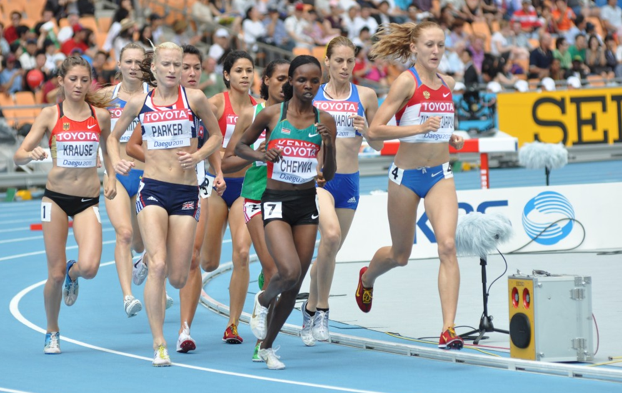
While in Daegu, South Korea last week where I delivered a lecture on biomechanics, barefoot locomotion and minimalist shoes at the International Sports Science Congress that was held in conjunction with the 2011 IAAF World Championships, I caught this photo during the preliminary heat of the 3,000 meter steeplechase where the USA’s Stephanie Garcia, a recent graduate of the University of Virginia, was running (she is fourth from the left). Our middle daughter, Kellyn, got to hang out with Stephanie a couple days before the heat thanks to our good friend, USA Throws Coach and remarkable OESHer, Carrie Lane, who snuck Kellyn into “Athletes’ Village” where the athletes were lodging and training.
I didn’t intend on this photo becoming a lesson in gait analysis but looking back at it I realize how nicely it depicts how we are vulnerable to injuries, not at impact (as everyone has always assumed) but when our foot is fully planted.
Look at their feet. No matter whether you strike the ground with your heel (as Stephanie does here) or with your mid or forefoot (as does the woman to the right of Stephanie), you always land on the outside part of your foot. The stresses to the body are minimal at this point. Note the lack of any muscle definition, which is an unsophisticated but fairly accurate indicator of total body stresses relating to peak joint pressures, stresses through bones, strains through injury prone tissues, etc., etc.
It is not until midstance, when the foot is fully planted, when the opposite knee passes the stance knee, that the stresses to the body are at their maximum (and are the culprit to all injuries). This photo catches only Parker during this critical, vulnerable, moment. Look at the muscle definition in her thigh and lower leg. It wasn’t there a split second before and it will be gone a split second later. Note that Krause and Chewya, who have passed beyond midstance, no longer have that muscle definition.
This photo illustrates elite running–a pure, clean example of the human frame in movement. But the same phenomenon occurs in everyday walking. Exactly as in the split second of this battle amongst the world’s greatest competitors, the substantial pressures through our joints that contribute to osteoarthritis do not occur at impact, but rather when our foot is fully planted.
Kellyn, Carrie, and I rooted like crazy for Stephanie. She held her own in this highly talented pack, with a remarkable time of 9:53.47. For her first World Championship event, it was truly awesome to see our hometown hero officially become, in a world of 3,000,000,000 women, one of the fastest 30 of them all.
***
This essay originally appeared on the OESH footwear blog. In the 3,000-meter steeplechase finals, the top three women were: 1.) Yuliya Zaripova, Russia, 9:07.03 ; 2.) Habiba Ghribi, Tunisia, 9:11.97 ; and 3.) Milcah Cheywa, Kenya, 9:17.16. As a followup to the essay, NRC asked Dr. Kerrigan for additional elaboration on gait analysis.
Her response: Integrating 3-D motion data with force plate information shows us that peak joint torques and forces related to virtually every repetitive injury do not occur at impact, as everyone has believed.
Rather, peak joint torques and forces related to osteoarthritis, stress fractures, etc., occur later in the gait cycle when the foot is fully planted and the body weight force is at its maximum. These peak forces occur twice in walking and once in running.
For years, athletic shoes have been designed around cushioning impact. But the typical foam cushioning in a shoe actually increases, rather than decreases peak joint torques that occur later in the gait cycle.
Meanwhile, a compliant human-ground interface (the Harvard Indoor Track) that does not cushion impact but rather compresses and releases in tune with the rise and fall of the peak body weight force, has been shown to reduce injury by 50%.
For years it may have been assumed that the soles of athletic shoes compress and release in tune with the rise and fall of the peak body weight, but they do not.

Hi Dr. Kerrigan. I’ve read a number of your articles indicating the critical importance of controlling the stresses of mid-stance. I understand that this is when peak ground reaction forces occur, but what leads to your confidence that these are the most critical injury causing forces? Dr. Irene Davis informed me that all of her research has lead her to believe that it is the forces at impact which are responsible for most running injuries; especially when the rate of loading is high in these forces. I’ve come to believe that both of these instances are related to running injuries, to various degrees depending on the area and type of injury, but this is just my speculation. You say that impact forces are minimal compared to the peak forces occurring at mid-stance. The GRF graphs that I’ve seen don’t make impact forces look minimal. Why do you consider these forces to be minimal? I think it’s apparent that rate of loading is important to consider when looking at impact forces, but do you think that rate of loading is also important in the mid-stance forces, or is it just important to be stable in this position and control how these forces are distributed into he body? Thanks. I look forward to trying on a pair of OESH shoes. I think Mark mentioned he has a demo pair in the store now.
Also of note during that same race was Mercy Wanjiku Njoroge, finishing 4th. Running with spikes on her right foot, barefoot on the left. I doubt she does the majority of her running this way, however is it insignificant not only how fore-rear we land assuming it’s lateral, but doing it differently across two feet?
at 5:43 race time
http://www.youtube.com/watch?v=dhxidk_T_lc